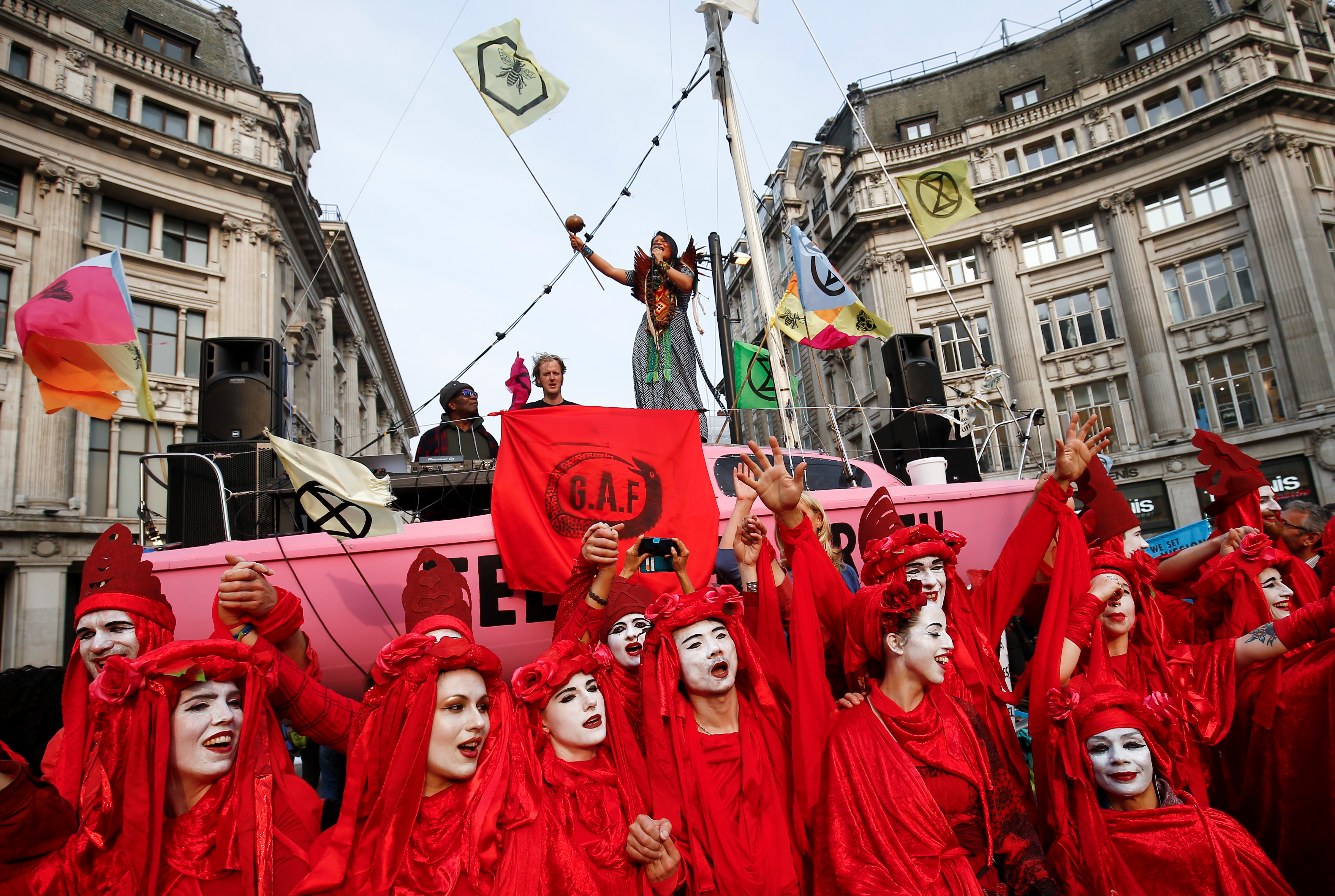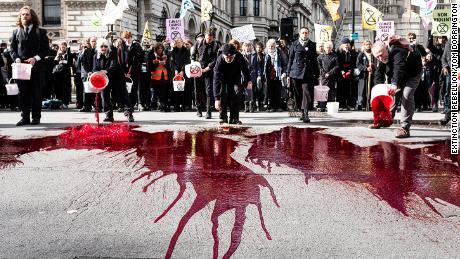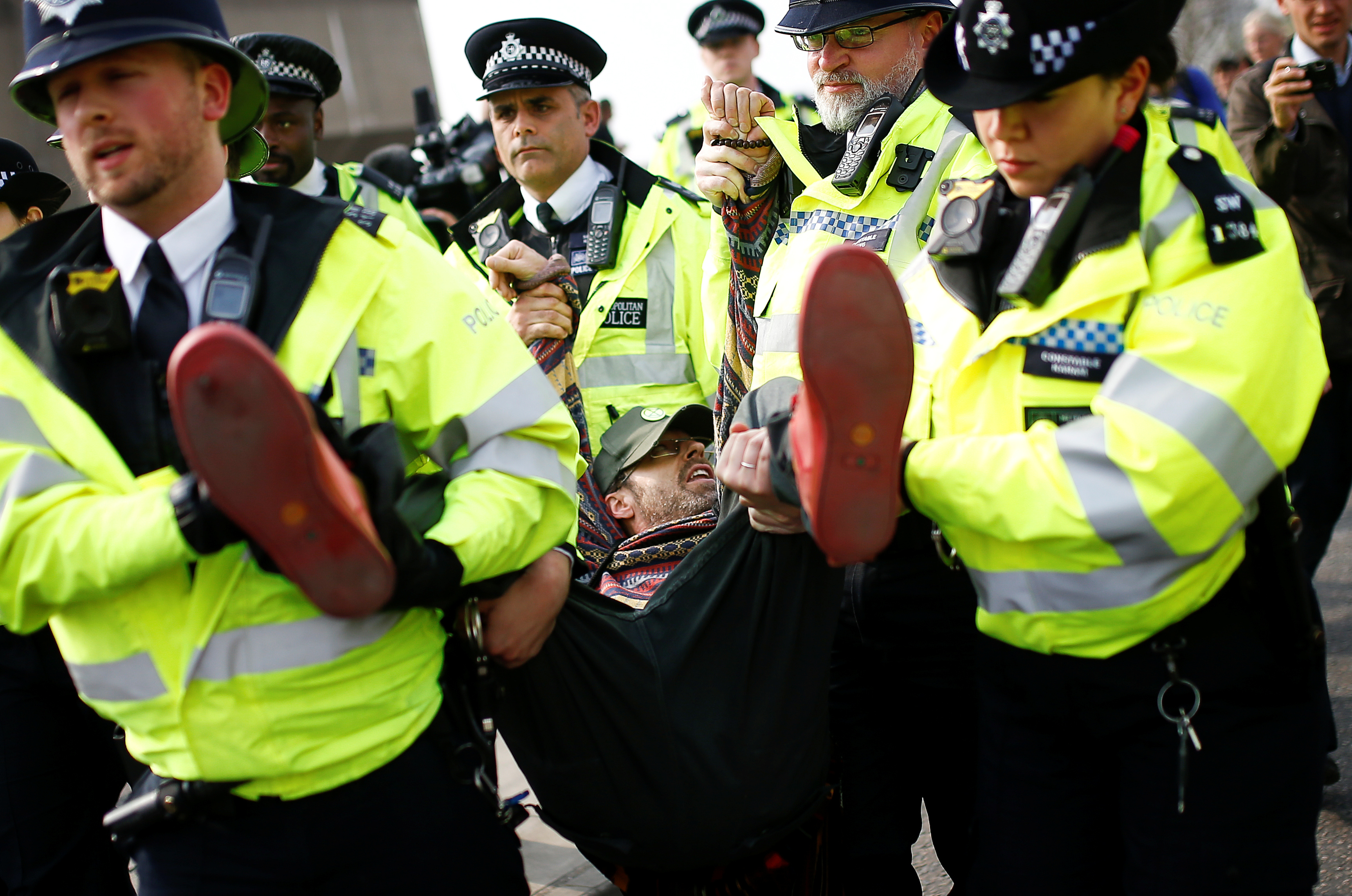
Can Extinction Rebellion Build a US Climate Movement Big Enough to Save the Earth?
(October 13, 2019) — A crowd of about 200 black-clad members of the climate activist group Extinction Rebellion gathered Monday morning at the southern end of New York City’s financial district. Some held banners painted with ghostly white animals or cardboard cutouts of trees and waves. In the background, a New Orleans-style jazz funeral band warmed up tubas, and one of the march’s emcees instructed people on the proper way to wail. (“Dig down and pull out your grief — because you gotta cry!”)
At the head of the procession, 20-year-old Ayisha Siddiqa took the megaphone. She explained how she’d come to the U.S. from a poor part of Pakistan when she was 5 years old and had lost family members as a result of frequent power outages, which are expected to increase globally as the climate crisis deepens. Attention turned to Richard McLachlan, a 68-year-old New Zealander, as he and another activist began reading Extinction Rebellion’s declaration of rebellion.
“The science is clear: We are in the sixth mass extinction event, and we will face catastrophe if we do not act swiftly and robustly,” the activists said. “We, in alignment with our consciences and our reasoning, declare ourselves in rebellion against our government and the corrupted, inept institutions that threaten our future.” It was the kickoff to an event dubbed Rebellion Week, part of an international series of XR actions.
As the group started moving out of the park, a figure appeared in the distance, waving Extinction Rebellion’s green flag from atop Wall Street’s charging bull statue. Dyed red corn syrup oozed down the bull’s back, and activists wearing white shirts splattered with fake blood played dead at the animal’s feet.
By sunset, police had arrested 700 people across the globe for participation in actions under XR’s banner, including 93 “die-in” participants in New York. That was the point. By getting arrested in visually compelling acts of civil disobedience inspired by Gandhi, the civil rights movement, and ACT UP, Extinction Rebellion hopes to jolt world leaders into taking action on the climate emergency.

Since the movement was born in the United Kingdom one year ago, it has grown to a network of at least 485 groups in 72 countries. Many observers have responded with a reaction similar to the one elicited by 16-year-old Swedish climate activist Greta Thunberg: Finally, someone is truthfully confronting scientists’ apocalyptic climate forecasts with the urgency they deserve.
Indeed, Extinction Rebellion’s ambition is no less than to save the Earth. To win, they say they need 3.5 percent of the U.S. population to participate. But whether a largely white, middle-class movement has what it takes to meet a sky-high ambition of mobilizing more than 11 million people to force sweeping climate action is an open question.
In the U.K., the group has been criticized for failing to center those most severely impacted by the crisis — people of color and marginalized communities. The New York-based chapter, founded a couple months after the one in the U.K., is in the midst of developing its own identity and proving that it stands for those who have the most at stake.
To members, sincere in their belief that a mass-appeal climate movement is what’s needed to quell catastrophe, drawing in front-line communities is life or death. As McLachlan put it, “This has to explode. It has to get bigger if it’s going to work.”
Preventing the Airplane from Taking Off
The weekend before the rebellion began, some 40 people sat in a circle in a community art space in the West Village as Bill Beckler, an Extinction Rebellion activist with a neatly trimmed beard and loose-fitting jeans, laid out terrifying climate scenarios.
He described “hothouse Earth,” a scenario introduced in a 2018 paper, in which processes initiated by climate heating, like permafrost thaw and forest dieback, become self-reinforcing feedback loops, causing the release of more greenhouse gases and stemming the planet’s ability to absorb them. He referenced another study that says there is a 5 percent chance carbon dioxide in the atmosphere could present an existential threat to humanity by 2100.
“If you told me to get on a plane that has a one in 20 chance of crashing, I wouldn’t get on that airplane,” Beckler said, his voice breaking with emotion. It’s Extinction Rebellion’s job to keep the airplane from taking off. “You guys are the ones.”
Beckler was there to train the group in nonviolent direct action, a requirement for anyone who wants to be arrested at an XR action. He was joined by Chelsea MacMillan, who wore her hair in a tidy pixie cut and had the posture of a yoga instructor.
He asked the group to close their eyes and take a moment of silence to let the facts he’d laid out sink in. “Hope is an empty, useless thing right now that stops people from doing what they need to do,” Beckler underlined.
Extinction Rebellion was founded in October 2018 by activists in the United Kingdom who had been despairing over the climate crisis. One co-founder, 47-year-old Gail Bradbrook, has written that the personal breakthrough that led to Extinction Rebellion was a direct result of two weeks she spent tripping on psychedelics in Costa Rica. Her background is indicative of the emphasis XR places on personal transformation.
Two months later, the New York wing held its first mass meeting. MacMillan, who founded the Brooklyn Center for Sacred Activism, told The Intercept she was attracted to the “regenerative” spirit of the movement, which encourages members to share their feelings and openly process grief. “We’re going to see things collapse.”

Extinction Rebellion’s No. 1 demand is that those in power “Tell the truth” about climate change. It’s why activists scaled the New York Times building in June and unfurled a banner that read “Climate change = mass murder,” with “change” crossed out and replaced by “emergency.” The group demanded the paper of record follow a set of standards that includes front-page climate headlines daily and the removal of financial conflicts of interest. Police arrested 66 people.
Less than a week later, New York City declared a climate emergency. (Whether the declaration will have much impact is a separate question.) XR pressure later led the Times to drop its sponsorship of the energy industry’s Oil & Money conference, an event it has had a relationship with for 40 years.
The truth, according to the Intergovernmental Panel on Climate Change, is that governments must act to cut greenhouse gas emissions in half by 2030 if they want to give humanity a 50 percent chance of avoiding unmanageable climate outcomes. Finding those odds unacceptable, Extinction Rebellion demands the goal be met by 2025. “Even if it sounds politically infeasible, it doesn’t matter. … We have to do it,” Beckler explained to the group.
He said the way to achieve that is to fulfill the third demand: a citizens’ assembly. Rather than endorse the Green New Deal, Extinction Rebellion argues that randomly selected individuals from the general public, reflective of U.S. demographics, should decide how the government should resolve the crisis. They would hear from experts and stakeholders before delivering recommendations. “The government enacts what the group comes up with,” he said.
That demand hasn’t been met in the U.S., but in the U.K., Parliament agreed to convene a citizens’ assembly last June, after police arrested more than 1,000 XR activists for blocking intersections and gluing themselves to infrastructure. The assembly’s recommendations will not be legally binding.
Although the U.K. movement makes only three demands, the U.S. chapter added a fourth: a just transition that establishes reparations for “Black people, Indigenous people, people of color, and poor communities,” where the sources of climate pollution pay for the damage they’ve caused.

The Police Are Not Your Friends
After the massive April protests in the U.K., Wretched of the Earth, a grassroots climate justice collective, published an open letter to Extinction Rebellion. “Our communities have been on fire for a long time and these flames are fanned by our exclusion and silencing,” they wrote. “Without incorporating our experiences, any response to this disaster will fail to change the complex ways in which social, economic and political systems shape our lives.”
The central XR tactic of mass arrests was at the heart of the criticism, since arrest is more risky for people of color, low-income people, and immigrants. In the U.K., Extinction Rebellion is known for communicating its plans to law enforcement and at times has given the appearance of viewing the police as collaborators.
“The strategy of XR, with the primary tactic of being arrested, is a valid one — but it needs to be underlined by an ongoing analysis of privilege as well as the reality of police and state violence,” Wretched of the Earth wrote. “Though some of this analysis has started to happen, until it becomes central to XR’s organising it is not sufficient.”
The relationship with police in the U.K. may be shifting. The same day as the direct action training, police raided a London building where Extinction Rebellion activists stored equipment, and arrested 10 people for conspiracy to cause a public nuisance. Specialist protest removal teams, made up of officers from across England, arrived in London to help handle the glue and locks protesters use to block infrastructure.
Meanwhile, activists in Paris were met with tear gas as they barricaded themselves in a mall for 17 hours. And in Australia, Extinction Rebellion members were preparing to fight legislation designed especially for them by the Queensland parliament, making activists who possess lock-down devices subject to up to two years’ imprisonment.
Protesters block the doors of the Italie Deux shopping mall in Paris during an Extinction Rebellion demonstration
MacMillan, like all Extinction Rebellion activists The Intercept interviewed, was well aware of the criticisms. She said part of the work of Extinction Rebellion U.S. is “finding the balance of using white privilege we have in the movement to stop the mess we’re in,” while also building relationships with communities of color. Although the group met with police in advance of the Rebellion Week, they did not share details of their plans. “We didn’t tell them anything except what’s on the website,” McLachlan said.
At the training, MacMillan discouraged activists from antagonizing police, but she also emphasized that the police were not their friends. “We try to maintain a quiet, neutral stance with police. We’re not trying to be buddy-buddy,” she said. “We are against the police as a tool of the state.”

Flatbush Attempts to Show the Way
On the Friday before the week of action, members of Extinction Rebellion Flatbush gathered in a blue-painted room with mini flags from countries around the world hanging from the ceiling. Located in the heavily South Asian Brooklyn neighborhood of Kensington, the space is an adult daycare during the day, but after 4 p.m., it’s the Pakistani American Youth Society community center.
Shahana Hanif, a 28-year-old Bangladeshi American and City Council candidate with a bright smile, described to the group how she worked to open the Avenue C plaza, which has become an important gathering place for Kensington — and a starting point for movement building.
Next, Bhumika Muchhala’s young daughter played on her lap as she explained the concept of climate reparations and described her work with the Third World Network, which brings the perspective of the “global south” to international gatherings like the United Nations climate talks. She pointed out that 100 corporations are responsible for 71 percent of global greenhouse emissions and that the U.S. is responsible for the largest proportion of carbon emissions driving the crisis.
Extinction Rebellion Flatbush, one of a growing number of neighborhood-based XR groups in New York, organized the event as a starting point for bringing in people who are more reflective of the neighborhood. “Flatbush is trying to show the way,” said XR Flatbush member Lorna Mason. But although about 40 people attended, very few appeared to be of South Asian descent.
The last presenter, McLachlan, gave a version of a talk he gives on subway trains, one of XR’s outreach tactics unique to New York.
He conceded to The Intercept that XR Flatbush, which he helped found, had failed in its first attempt to draw in South Asian neighbors. “There were very few of them here,” he said. He’s hopeful, though, that they can win trust by homing in on issues that impact community members, like organizing for air conditioning in Brooklyn schools.
“To be honest, I think it’s more than that,” said Kashif Hussain, a community organizer who founded PAYS and also spoke at the event. “I’m kind of happy they didn’t come, because the presentation wasn’t geared toward them anyway.”
It might have been more compelling if it included slides specific to climate impacts in South Asia, Hussain said. The presentation “is geared toward educated folks and people who are willing to be involved in civil disobedience.”
There have been plenty of climate-related uprisings led by people from vulnerable communities. During Standing Rock, a massive anti-pipeline movement led by the Standing Rock Sioux tribe in North Dakota, police arrested more than 800 people. Indigenous people took some of the biggest risks and faced some of the most severe charges.
In Puerto Rico, hundreds of thousands of people, including islanders from low-income neighborhoods who had never before protested, went into the street to demand the resignationof Gov. Ricardo Rosselló, who oversaw the botched response to Hurricane Maria. They won, and he stepped down.
In the Sunset Park neighborhood of Brooklyn, the Latina-led organization Uprose has been doing climate justice work for 15 years. The organization’s director, Elizabeth Yeampierre, said she’s wary of new climate activist groups that have popped up asking her to join their cause. “This is not trendy for us,” she said. “We are in this for the rest of our lives.”
To make Extinction Rebellion successful in Kensington, they’d need a friend of the community to take on the hard work of developing programming around the climate emergency and organizing people who aren’t already radicalized around the climate crisis, Hussain said. “Community members like me could be that catalyst, but without proper resources, it’s virtually impossible.”
McLachlan said he’s committed to doing what he has to. “I’ll come back as often as it takes,” he said.
:no_upscale()/cdn.vox-cdn.com/uploads/chorus_asset/file/19267554/akrales_191007_3711_0265.jpg)
Preventing the Next Apocalypse
Monday’s procession moved from the charging bull to the New York Stock Exchange, where more fake-bloodied Extinction Rebellion bodies were strewn across the pedestrian-only road. Many marchers carried gravestones with the names of environmental defenders who have been murdered throughout the globe.
Bob, a 50-year-old bystander, said he worked at a brokerage firm nearby. Asked about Wall Street’s role in the crisis, he said, “I think it’s very clear. That’s capitalism. It’s obviously broken.”
Bob said his employer’s parent company funds oil and gas pipelines. He threw his hands in the air. “I guess I’m a part of the problem until I’m part of the solution.”
The procession veered east down Pine Street. In front of Trinity Church, activists linked arms in the middle of Broadway Avenue and blocked a two-decker tourist bus. One passenger looked down from the upper deck with delight.
In the week that followed, New York XR members conducted a sit-in at Columbia University’s Low Memorial Library and blocked a nearby intersection. Activists glued themselves to an 18-foot boat parked in the middle of Times Square, leading to 62 arrests. In the U.K., police arrested more than 1,000 people throughout the week, as they conducted actions at the London airport, blocked the entrance to the BBC, and carried out other disruptive protests. XR activists held actions in 60 other cities, including Sydney, Madrid, Vienna, Buenos Aires, and Mumbai. The premier of Queensland, Australia, announced that she would fast-track the anti-protest legislation.
As the Monday procession broke up, many made their way toward Washington Square Park for the launch of a weeklong Rebel Fest, where Extinction Rebellion set up family-friendly events to complement the civil disobedience happening in other parts of the city. Owl, a member of the Ramapough Lenape Nation who was involved in fighting an oil pipeline in New Jersey that would have passed through his people’s territory, was invited to present an acknowledgment that the festival would be held on stolen land. “The bottom line is that they have an important message, which is what we are doing now is causing a global mass extinction,” Owl told The Intercept.
“Indigenous people, black people, people of color have been on the front line since before there was a formal environmental movement,” he said. “I’m looking forward to further ties with Extinction Rebellion, and this is a good start.”
Owl took the megaphone before the crowd of Extinction Rebellion activists. “We’ve been through an apocalypse before,” he told them. “And I can tell you it’s not pretty.”
Posted in accordance with Title 17, Section 107, US Code, for noncommercial, educational purposes.